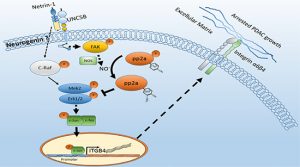Oh, no. You must understand, in the late 80s and 90s, growth cone navigation was my jam. It’s what I was doing research on, and my head was full of papers from that era. Netrin, robo, slit, various molecules that attracted or repelled growing axons to establish the pattern of connections in the early developing brain…that was what I did. Now I learn that some of those papers, those written by Marc Tessier-Lavigne, were a lie.
Marc Tessier-Lavigne, the former president of Stanford University who resigned following scrutiny of his published papers and an institutional research misconduct investigation, has retracted a third paper, this one from Cell.
Last week, Tessier-Lavigne retracted two articles from Science that had been published in 2001.
The Cell paper, A Ligand-Gated Association between Cytoplasmic Domains of UNC5 and DCC Family Receptors Converts Netrin-Induced Growth Cone Attraction to Repulsion, was published in 1999. It has been cited 577 times, according to Clarivate’s Web of Science.
In my circles, Tessier-Lavigne had a colossal reputation — he was turning out all this work from a prestigious, well-funded lab with an army of students and post-docs. I was teaching developmental biology, talking about netrins, with a textbook that already cited the Tessier-Lavigne work. Such cool stuff, and it can’t be trusted anymore.
Worse, can we trust Cell magazine? They’ve posted the retraction, and it admits that the editors didn’t care about faked data.
In 2015, we, the authors, consulted with Cell editors about issues that had been brought to our attention about this paper, specifically image splicing in Figures 3C, 5A, 5B, and 7B–7D and duplication of blank blots in Figure 7C. Cell declined to publish a Correction at that time because in 1999, when the paper was published, the journal did not have policies prohibiting unmarked image splicing and because, for the duplication, there was insufficient information to determine intent, and the impact of the duplication on the paper’s conclusions was limited. In 2022, when new concerns were raised, Cell posted an Editorial Expression of Concern (Cell 186, 230 [2023], https://doi.org/10.1016/j.cell.2022.12.019) while an institutional investigation was conducted. The investigation is complete and has revealed further issues including manipulation of data-containing portions of Western blot images in Figures 3A–3C, 7A, 7B, and 7D, undermining confidence in the paper’s conclusions (https://boardoftrustees.stanford.edu/wp-content/uploads/sites/5/2023/07/Scientific-Panel-Final-Report.pdf). As a result, we are retracting the paper. We regret the impact of these issues on the scientific community.
Yikes. All it should take is one fudged image to cast doubt on the entire paper. If you’re faking data, we have sufficient information to determine intent — I was brought up with strict instruction that you never never never never ever do that.
What a disgrace. Shame on Tessier-Lavigne, and shame on Cell.



Why would anyone do this? Isn’t getting caught inevitable?
He got away with it for about 30 years, long enough to climb to the presidency of Stanford.
(i) the number and nature of the errors in the paper make intentional manipulation the only plausible hypothesis
(ii) regardless of intent, the paper should have been retracted when the errors were pointed out in 2015
(iii) the fact the Cell refused to even issue a correction in 2015 is damning
(iv) why are ‘we, the authors’ explaining Cell’s editorial decision-making?
(v) why is the burden of proof for retraction so high? The Stanford report is a powerful piece of work and I respect the thoroughness given the stakes involved…is Cell really saying they won’t retract a paper with blatant image manipulation unless there’s a massive institutional investigation? (in this case: an externally appointed law firm, five very senior scientists, forensic analysts, 50 000 documents reviewed, and gawd knows how much money lost)…
I should add that, even though the Stanford investigation was thorough, it is still very much about protecting the reputation of Stanford, and that entails protecting the reputation of Tessier-Lavigne as much as possible. It’s a kind of ‘mistakes were made, lessons learned’ report that does not, imho, match the failures reported. I’m sorry, but as the most senior scientist in that lab, and as lead author of five of the papers, and repeatedly refusing to issue corrections once problems had been brought to his attention, saying ‘Dr. Tessier-Lavigne did not have actual knowledge of the manipulation of research data that occurred in his lab and was not reckless in failing to identify such manipulation prior to publication’ just doesn’t cut it.
I don’t know much about the history of science but I have a feeling that we are in a unique era of “mass produced BS science”. Am I biased by personal experience or is there something to this?